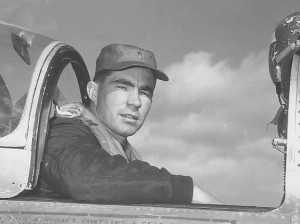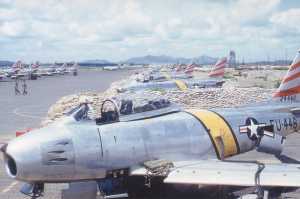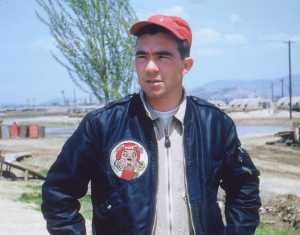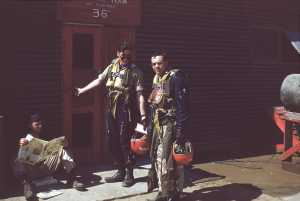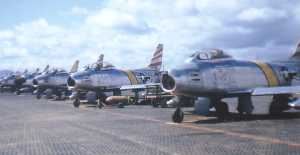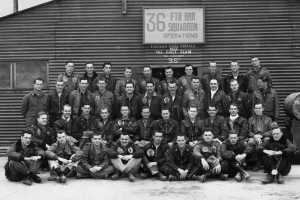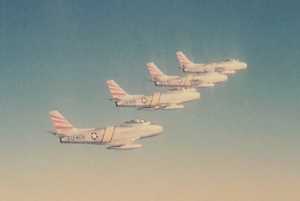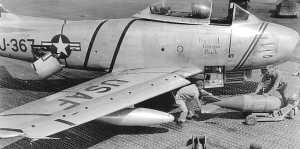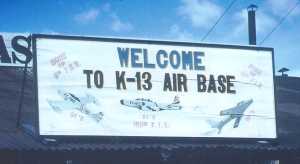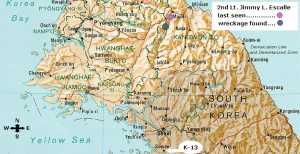Jimmy L. Escalle
Fighter Pilot MIA in Korea
By Jim Escalle, July 17, 2011.
After 2nd Lt. Jimmy Escalle finished combat crew training at Nellis Air Force Base, he was assigned to the 36th Fighter-Bomber Squadron (Flying Fiends), which was one of three squadrons assigned to the 8th Fighter-Bomber Group at Suwon Air Base (K-13) in Korea. The unit had been involved in the war from the beginning, flying F-80 Shooting Stars from Itazuke Air Base in Japan. When the 8th Group moved operations to Korea, they continued to fly F-80s, but switched to the F-51 for a brief time. Trading in their Mustangs for F-80s again, the pilots continued their fighter-bomber role, even though at the start of the war the squadron was successful in air-to-air combat, shooting down several North Korean aircraft.
On February 26, 1953, the 36th FBS stopped combat operations with their F-80s and began the transition to the F-86F Sabre. Jim arrived at K-13 a couple of days after this turnover began and was excited to learn that he would begin his combat tour flying the new aircraft.
The following is compiled from the chapter “Fighter-Bomber Missions” in my book, Unforgotten Hero: Remembering a Fighter Pilot’s Life, War, and Ultimate Sacrifice.
In early April 1953, the 35th and 36th Fighter-Bomber Squadrons were ready to fly combat missions with their F-86Fs. Before doing this, however, two pilots from the 51st FIG came over from the west side of the base to give the 8th FBG pilots some tips on air-to-air tactics. Capt. Joseph McConnell, Jr. from the 39th FIS and 1st Lt. Howard Leaf from the 25th FIS gave a “pep talk” to the guys before they went on their first missions, which were going to be MiG Alley sweeps. Leaf was in the 80th FBS before extending his tour with the 25th; therefore he was experienced in both air-to-air and ground support missions. McConnell was one of the leading aces at the time, credited with shooting down seven MiGs. He shot down his eighth MiG about a week after he and Leaf gave their talk. Over the next month and a half, McConnell would go on to shoot down eight more, becoming the highest scoring ace in the war, and one of only two triple aces in the war.
Because he was a “new head,” Lt. Escalle didn’t get to fly on as many of these early interceptor missions as he wanted, and was even a bit frustrated at the lack of missions being assigned to him. On April 16, Jim took a short break from his assigned duty to write a letter to his future sister-in-law, Jean Woekel, telling her about some of this frustration, along with letting her know how things were going. Being the big brother, he was still concerned about Bob, hoping that he wouldn’t have to come to Korea after he graduated from pilot training. Jim wrote:
Dear Jean and family,
Well, I am pulling O.G. tonight, so I have time to catch up on my letter writing. Some nice stateside music is on, ha! We have it pretty good here, fair quarters and chow. We have houseboys, and waiters (boys) every night.
I am flying F-86s and have one mission up to MiG country. I wish we flew more, but the “old heads” have the seniority. I am supposed to get a mission tomorrow. One of our boys got shot down today at about 10:00, and he just walked in here now (18:00). He bailed out and they brought him back by airplane. He seemed happy to be back.
The MiGs are much more aggressive lately. That's what we like! We are going into bombing pretty soon. I hope we start flying missions more regular. I wish they would end the war or get down to business. Well, that's enough war.
I bet the weather is nice there now. Tell your folks and everyone hello. My dad is looking forward to Bob's graduation. You're going back too, aren't you? I am going to get a real good wedding present for you when I can get to Japan. It will be worth waiting for, good excuse. I bet Bob is really looking forward to graduation. I hope he gets F-86s.
I hear that most of the guys are getting to stay in the States, or going to Europe now. They don't need pilots over here; they have too many. The weather here is getting warmer. It was cold at first. I am sorry about the writing. I want to say something, but I can't write it down fast enough. I am going to take lots of pictures, so ask Bob for them.
Bob has worked hard in the “program” and I know he's a good pilot. He deserves to get a rest and good assignment now. I hope he doesn't have to come over here.
Well, there's not much to write about from here. When we start air-to-ground work, I will have some good stories. We're the first outfit to use the F-86 Sabre for bombing, strafing, against troops, etc. So it should be interesting. If we're not going to get any missions here, then I want to leave and go to Germany. Good deal, huh? Well, I'll try to write something worthwhile next time. They exchange prisoners tomorrow. It's about fifty miles north of here. Tell everyone “hello.”
So Long,
Jim
After writing this letter, it was only about a week before Escalle went on his first fighter-bomber missions, which he liked just as much as the small number of MiG Alley sweeps that he flew. To him, blowing up a bunker or bombing a bridge was just as satisfying as getting the opportunity to shoot down a MiG-15, though he would have preferred doing both. But with two well-established fighter-interceptor wings already in Korea—the 51st FIW at K-13 and the 4th FIW at K-14 (Kimpo)—most of his missions would be air-to-ground.
The prisoner exchange that he mentions at the end of his letter was called Operation Little Switch, which started on April 17 and continued for the next five days. It put a hold on any combat missions. Although Escalle was supposed to get a combat mission on the 17th, according to what he wrote in the letter, only reconnaissance missions were flown while the sick and wounded prisoners were being swapped. When combat operations began again after this troop exchange was completed, the 36th FBS was back in the air, with the majority of the targets being troop concentrations, or bridges that needed to be knocked out.
During the month of May, the pilots in the 36th FBS went on their first close air support missions with the F-86s, and were assigned their first “truck alert” missions with the new aircraft. The Chinese and North Koreans naturally brought trucks full of weapons, ammo, and other items into the front line area; and because they usually drove at night, the pilots had to attack them after dark.
By the middle of May, all three squadrons of the 8th FBG were flying the F-86F Sabre on air-to-ground missions. Fighter-bomber missions were assigned to the 8th on a regular basis, spreading them out among each squadron. Sometimes weather played a crucial role in whether a mission could be carried out, or if it would be postponed or cancelled.
One particular target, known as J-14, was assigned to the 8th Group on nine different days of the month. Bad weather was the reason for the repetition of these missions. This target comprised of four heavy artillery guns located north of the front lines in the eastern sector area. It was a famous target for almost all the fighter-bomber pilots in the Group. The guns were well hidden and very hard to get at, but they were actually hit three different times, and 150,000 pounds of bombs were placed directly in the target area.
When the month was over, the 8th FBG had flown over 60,000 sorties, setting another record. Jim had over 20 missions by this time and was looking forward to more. Some of these missions included dropping 1,000-pound bombs on a multitude of tactical targets, with one of them being the heavily defended bridges at Sinanju; skip-bombing dams while flying only a few feet off the ground; going on armed reconnaissance patrols and shooting at targets of opportunity; dive-bombing enemy troops and supplies; and close air support missions on the front lines.
As every fighter pilot in Korea was required to do, Escalle hoped to fly 100 combat missions, even though he knew that he probably wouldn’t get that many by the time the war was over. However, he still would give up a scheduled R&R (rest and relaxation) in Japan to fly as many missions as possible.
In a letter that he wrote to his brother Bob on May 24, he mentions this along with a few other minor things. Bob and Jean had been married two weeks earlier, after Bob graduated from pilot training, and he was now at Nellis AFB going through gunnery training.
Dear Bob and Jean,
Well, how do you two like that married life? I am glad you found a nice apartment in Vegas. I know Bob will like the training there. Jean, you should like the town and nightlife. Bob will only see that on Saturday night if I know that flying. It gives you a workout.
I'd like to have seen your wedding. I hear it was really nice. I know you two will have a fine time. I hope you had enough time for a honeymoon. By the way, I sent your wedding present. I think you'll like it.
I hope something is settled soon so Bob doesn't have to come over here. You two sure would be lucky if Bob was sent to Germany. I hope to go there after leaving here. That would really be a deal.
I hope Bob gets a good leave after Vegas. I bet that valley looks nice and green now. Vegas should be nice this time of the year, too.
So you're hearing about our new role as fighter-bombers in F-86s. We really have lots of fun in this dive-bombing. Did you wear the tires off that Oldsmobile already, ha!
I'll be going over to Japan in another month for an R&R. I passed mine up this time to get more missions. It's all right when you're flying, but it's really dull here when you're not.
I got the package with the pencils, fatigues and knife. The package was partly open so I thought that maybe someone took the red baseball caps out. Did you send the caps?
I just got back from a week out at our gunnery range. I was range officer in charge. I got a good suntan and rest. I got to watch lots of bombing, strafing and even some napalm. A .50-cal. hit a little girl, so we sent for a “chopper.” It came and picked her up. We really had a crowd around there to watch. I am trying to catch up on the missions I lost now.
Well Bob, I guess you're looking forward to flying the F-86. It's really a wonderful airplane. Flying it at Nellis and combat are lots of fun.
I can hardly think of anything to write. Not much is going on here. I bought a new camera. It's a C-3 Argus and I've been taking colored slides. They really come out nice. I am sending them home. They won't let us take pictures on the line yet. I'll try to get some of me in “battle dress” and of the planes.
Bob, give me a line as soon as you check out in the F-86. In another month, I'll be going over to Japan and have a weeklong party. This buddy of mine just came back, and he told me about everything he did. I almost applied for an R&R right then, ha!
We have been getting some good bombing missions lately. Those 1,000-pounders really tear things up. This afternoon, we went on a patrol mission right up by the Yalu. You could see the MiG field at Antung. There weren't any MiGs flying, so we didn't get to mix it up. My ship started losing rpm (%) and I thought I was going to have to walk home, ha!
Well, that's about it, newlyweds!
So Long,
Jim
As the month of June began, more combat missions were finally assigned to Jim. Almost all of them were close air support missions, because the small but deadly battles along the MLR (Main Line of Resistance) near the 38th parallel had grown more intense by this time.
On June 8, as he and his flight leader, 1st Lt. Jack Mayo, were taxiing back to their revetments after completing a mission, Escalle spotted two airmen trying to put out a fire near an F-86. Apparently, an APU (auxiliary power unit) had caught fire when a .50-caliber round from a parked Sabre was accidentally discharged, piercing the gas tank of the APU. Unconcerned about his personal welfare, Jim stopped his plane, unbuckled and got out. He rushed over to the burning APU, went through the flames to disconnect it from its F-86, then pushed the unit out of the way before the fire caused serious damage to the plane. As soon as the unit was safely away from the area, two other airmen brought over a fire extinguisher and quickly put the fire out. Jim suffered some minor burns to his face, but nothing to warrant medical attention. He was later awarded the Soldiers Medal for this selfless deed.
Escalle didn’t mention this incident when he wrote a letter to Bob and Jean on June 11, only five days later. Nor did he mention the Air Medal that he had received earlier. His concern in the letter focused again on Bob not coming over to Korea. Bob was flying F-86s at Nellis by this time and had sent Jim a letter asking what squadrons he was in while he was there. In this letter, Jim responded:Dear Bob and Jean,
I just got back from a mission. It's really raining heavy, so I guess we're through for the day. I have about 30 missions now. I hope to get 50 or 60 before this war ends, if it does. I hope you get to stay in the States, Bob. Stay there if you can work it. In this bad weather, we go up in the “soup” and drop our bombs by radar. They can get the accuracy down to about 30 yards. Pretty good, huh! We're having lots of bad weather this month. If this war ends, we'll probably be stuck over here on occupation duty.
I haven't taken an R&R yet because I'm trying to get missions. I am sure looking forward to going back to the States. Then I hope to go to Germany. We have been having air raids the last two nights.
Say Bob, could you send me about 6-8 pair of those white gym socks. I've worn all mine out. You know, the kind we always wore. I am glad you and Jean have a nice place to live. You should be getting that wedding present I sent you pretty soon. I will be sending more pictures soon. Color slides and some big one of a formation. This big one of the formation is to be enlarged to about 5 feet by 6 feet and put around the base. I am flying number four in FU-399 in the picture. The plane belongs to Lt. Lloyd Irish, a pilot in my flight.
When I was at Nellis, I went through F-80s in the 94th Squadron, then through the 25th Squadron in F-86s. Well, tell everyone “hello” for me. Nice pictures!
So Long,
Jim
Over the next two days, mainly due to bad weather, Escalle wasn’t assigned any missions. A pilot rarely went on more than two or three missions a day, even with clear weather, and that was followed by many more days of sitting around waiting for a mission to come up. This tedious waiting frustrated the pilots perhaps more than anything else. They wanted to fly combat missions, not sit outside the Ops building doing nothing. It wasn’t long, however, until they got what they wanted. The third week of June began with news that the Chinese had already amassed thousands of troops near the MLR and something big was getting ready to happen.
On June 15, 1953, while it was still dark, the Chinese armies broke through the ROK (Republic of Korea) sector of the MLR in the Pukhan River Valley. This was the big Chinese push that began days earlier, and now they had broken through the weak area of the front lines where it was defended by South Korean troops.
The Chinese and North Koreans knew that a truce could be signed and be put into effect at any time. They also understood, according to the potential outline of this truce that whatever territory they occupied at the time it went into effect would be theirs to keep. So they attacked in full force, with heavy artillery and armor backing them up.
Almost immediately after the breakthrough, the call came through to 8th FBW headquarters for the need of close air support in the eastern sector of the MLR, where the majority of deadly fighting was taking place. The pilots of the 8th FBG were then hurriedly called into action. Before the first rays of the sun penetrated the eastern horizon, the pilots in the 36th FBS, fully dressed for battle, climbed into the cockpits of their red-tailed F-86F Sabres. Under the command of Maj. Robert C. Ruby, they launched a 15-hour unrelenting assault on the front lines, strafing and dive-bombing the vast onslaught of Chinese troops, trucks, armor, and supplies.
With antiaircraft weapons being fired at them from all directions, along with a myriad of small arms fire, the pilots flying these close air support missions would first work into attack position over their selected target. Then, under the watchful direction of a Forward Air Controller flying in his slow-moving T-6 spotter aircraft, each pilot in a four-ship flight would, at approximately one minute spacing intervals, slowly push forward on his plane’s hydraulically-controlled flight stick, tilting the nose of his Sabre down at the proper angle of attack (usually 45 degrees) and dive into the target. He then released his 1,000-pound bombs at just the right moment before pulling back on the stick, feeling the G-forces as his aircraft methodically came back up from this steep dive. The FAC, himself being in harm’s way, always gave an assessment of the damage done. In most cases, he fired a “Willie Pete” (white phosphorus) rocket into the selected target area to pinpoint the spot where the fighter-bomber pilots needed to drop their ordinance.
But there was no room for error after beginning his run, and a fighter-bomber pilot had to put all of his attention on keeping the plane at the right angle of attack, as well as remembering when he had to pull up. If he didn’t begin his pull-up at the proper altitude (around 3,000 feet), his aircraft would be more vulnerable to the accurate range of the antiaircraft guns. Also, if a pilot’s plane was hit at a lower than safe altitude while on his dive-bombing run, he might have a hard time controlling his aircraft and could very easily slam into the ground. This happened to a lot of good fighter-bomber pilots who were hit during their bomb runs.
During this massive air assault against the Chinese, most of the pilots from the 36th FBS flew at least three or four of these type missions apiece, and a few of the “old heads” were able to wrangle five missions each. Nevertheless, the pilots couldn’t do their work alone. They heavily relied on the motivated, tireless, and courageous effort of the ground crews. The turn-around times were fast and efficient owing to the dedicated work of the crew chiefs, refuelers, and armament personnel. At the end of this arduous day, when all the assigned missions were finally completed and the last sweat-soaked pilot, with the help of his crew chief, wearily climbed out of his cockpit, the 8th Group was notified that it set another record by flying 290 sorties. The 36th FBS was told it racked up 121 sorties, breaking the record set by the 80th FBS with their F-80s back in April.
On June 16, the squadron repeated their missions, though they were fewer than the day before. The next two days the weather made it impossible to fly. On June 18, the second of these two flightless days, was a Thursday. Because Escalle didn’t have to fly he was given the assignment of airdrome officer. Around 8:30 a.m. he took a short break to write a couple letters, with one to his brother explaining some of the missions he had gone on during the squadron’s two-day assault against the Chinese. In this letter Jim writes:
Hello there,
Well, I am A.O. today so I finally found time to get off a couple of letters. I hope you're flying by now. I bet you and Jean know Vegas pretty well by now. I hope you don't have to come over here Bob. It would be better if you could stay in the States. It would be nice if you went to Europe.
I imagine you have been reading in the papers about the big push that the Chinese have made on our lines. I don't know how big they said it was, but it was big. The day it started they had us in the air before the sun was up and we didn't land until 9:00 that night. I got four missions that day and was so tired I could barely walk, but it was fun. We kept this up for two days and then the weather came in. I got eleven missions in three days. The day before the push started I got three missions, and for the next two days I got four missions each day.
On the day I got three missions I had an interesting day. Our first mission that morning was a dive-bombing mission on troops and supplies. We really plastered that target. The second mission was a Yalu River sweep. On this sweep we climbed to 40,000 feet and dropped our tanks, then we climbed on up to 47-48,000 feet and started patrolling the Yalu River. We had just started west on our patrol when ten MiGs came right across our nose. They were going in just the opposite direction as we were. By the time we turned they were way out in front of us. We finally had to break it off because we were patrolling a certain area. If we could have seen them a little sooner, we might have gotten a head-on shot or got on their tails sooner. Anyway, I have seen MiGs, ha!
I hope we can go on some more of those missions. When I dropped my tanks, they rolled out the wing and tore the Pitot tube off. Then my radio went out. So I really had an interesting Yalu sweep. I had to make a formation landing due to the airspeed being out.
The third mission that day was a skip-bombing mission on a dam about 50 miles from Antung. We came in at about 15-20 feet off the deck and bombed the dam. So that was an interesting mission.
The next day, the big push started and we were hitting the front lines just as the sun came up. The T-6 directs us on these type missions. The sky was full of F-86s, F-84s, Navy and Marine planes. We bombed those “Chinks” all day and after dark. After dark, we went down roads behind the lines and shot up trucks. The flak was really heavy for these two days. We lost two F-86s from our Group due to ground fire.
The sky was almost full of flak. After dark you could see the tracers. It looked like a Fourth of July in the late evening. There were lots of trucks moving up to the front after dark. Boy, as soon as you would start down for the trucks, they would open up from both sides of the valley.
We really worked hard for those three days and I think we helped the soldiers a lot. Right after dark, you could see how hard they were fighting by all the flashes. Everyone still thinks the truce will be signed. The Chinese are just trying to get some good hills right now.
Well, enough on the war. I'll write you some more if I get some interesting missions. I have 40 missions now, hurrah! We finally got a good night's sleep and a shower after three days, due to the rain last night. I don't know how long it will take for that wedding present to get there. Well, I better get back to work. Tell everyone hello.
Hey, on the first day of that big push, my squadron set a group, wing and 5th Air Force record for sorties. We got 121 that day. Those crew chiefs and armament men really worked for us to set that record. Have fun!
So Long,
Jim
The missions into North Korea were just as hazardous, if not more so, than the ones near the front lines. With the plethora of Soviet-equipped radar ranging antiaircraft batteries strewn about on almost every hill and valley in North Korea, along with the vast array of 37mm automatic weapon platforms strategically placed in various locations, it would be tragic if a pilot got a fatal hit on his aircraft before, during, or after striking his target. The chances for reaching friendly territory before bailing out would be very small, if not impossible. When the 36th FBS took to the skies again on June 19, this scenario came true for one pilot from Mike Flight.
While flying as element leader on an armed reconnaissance mission in North Korea, Escalle and his wingman, 1st Lt. Jack Senneff, spotted a convoy of camouflaged trucks on a dirt road parallel to the Imjin River, southwest of Wonsan. Since he and Senneff were making their strafing passes in opposite directions to avoid as much antiaircraft fire as possible, they lost visual contact with each other and maintained their relative positions to the trucks by radio calls.
Escalle called that he was going in on his second pass, so Senneff remained high waiting for the call that Escalle was off his target. When this call did not come for several seconds, Senneff began his second pass, having decided that Escalle was already off. Upon pulling off the target, Senneff called Escalle for his position but received no answer. He then began circling the immediate area looking for Escalle and calling him repeatedly from the radio. After considerable time in circling, calling and receiving no answer or sight of Escalle, Senneff had to return home due to low fuel.
A short time after Senneff returned to K-13, a ResCAP (rescue combat air patrol) was sent out to see if they could find Escalle or his aircraft. After several minutes of searching, the smoking wreckage of an aircraft was seen about 8 miles from the target area. When the flight got closer, they saw it was an F-86 because the complete tail section was there along with part of a wing, but no sign of Escalle. He was reported missing in action.
Although Escalle’s body has never been found, he is not forgotten. In his memory, a headstone was placed near his father’s grave so family members could remember his sacrifice. A memorial college scholarship was established by some of his high school friends in the 1990s. And in the summer of 2004, as a permanent memorial to Jim’s contribution in the field of aviation, his name was submitted to the Smithsonian National Air and Space Museum’s Steven Udvar-Hazy Center to be placed on their Wall of Honor. Jim’s name can now be seen alongside other F-86 Sabre pilots who defended freedom in Korea, as well as those who defended it elsewhere.
More information about Jim Escalle and the upcoming book at Unforgotten Hero.

